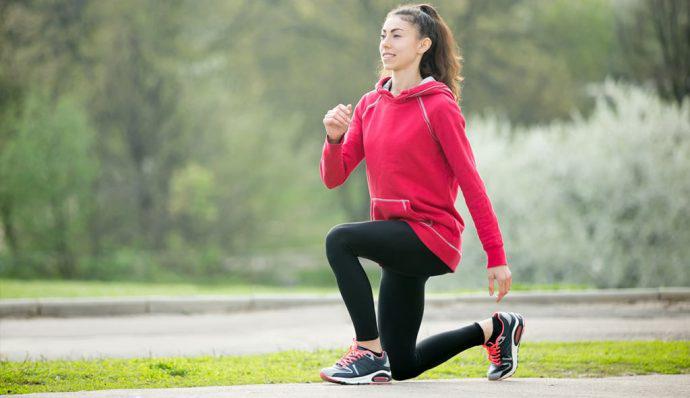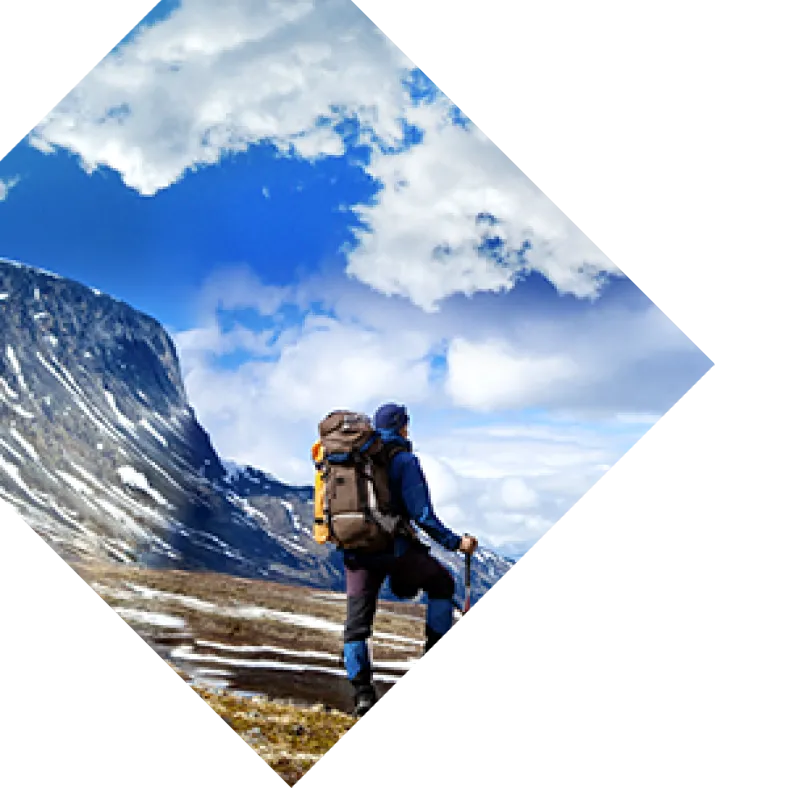It is easy to conjure up an image of a picture-perfect hike: an empty trail that winds alongside a babbling brook through a verdant and lush valley before ascending a towering peak with a rocky and ferocious ridgeline. And those views from the summit? Fan-freaking-tastic. But, there is one thing missing from this idyllic image: the sweat equity required to handle the physical nature of a hike. While hiking is absolutely a mental escape, it is a labor-intensive activity that calls for muscular strength and cardiovascular endurance. Those scenic views won’t be as enjoyable if you are too busy sucking wind to soak in the landscape, right?! This is why it is important to regularly incorporate workouts for hiking into your fitness regime. These specific exercises will tone and strengthen the muscles that you use while hiking on trail, leaving you with more speed, agility, and endurance so you can better enjoy the goodies that nature has to offer. (As always, please consult a doctor before adopting a new exercise routine.) 
Exercises for Hiking
Goblet Squats
Goblet squats are a great exercise for hikers since they target all of the bigger leg muscles including your quads, hamstrings, and glutes. These muscles are the ones you predominantly use while hiking, so it’s a good exercise to have in your toolkit. As an added bonus, they are easy to do, too! How to do it: Grab a kettlebell (or a dumbbell if that is what you have) between your hands and hold near your sternum. Place your feet about hip width apart and keep your weight in the heels. Slowly descend until your thighs are parallel to the floor, ensuring that your knees track over your toes rather than bowing inwards. Once you hit parallel, power through your heels to stand up straight until your hips are fully extended. This counts as one rep. The heavier the kettlebell, the harder the squat, so gradually build up the weight used for a tougher exercise.
Step-Ups
 Steps-ups target your quads and glutes, which are important muscles for climbing mountains. These can be done at any gym with a box, but if you don’t have a membership, they are easy to do at home, too. Use a staircase or bleachers at a school if you are searching for ideas. How to do it: Stand facing your box or bleacher. If this is a new exercise for you, start with a lower box; aim for 10-16 inches in height. As you become more comfortable, opt for taller boxes. Raise one foot to the top of the box and use your muscles to step up onto the box. Fully extend your hips at the top of the box so that you are completely standing upright with both legs. Use that same leg to step down. Then, switch to your other leg for the next rep.
Steps-ups target your quads and glutes, which are important muscles for climbing mountains. These can be done at any gym with a box, but if you don’t have a membership, they are easy to do at home, too. Use a staircase or bleachers at a school if you are searching for ideas. How to do it: Stand facing your box or bleacher. If this is a new exercise for you, start with a lower box; aim for 10-16 inches in height. As you become more comfortable, opt for taller boxes. Raise one foot to the top of the box and use your muscles to step up onto the box. Fully extend your hips at the top of the box so that you are completely standing upright with both legs. Use that same leg to step down. Then, switch to your other leg for the next rep.
Downhill Lunges
 Lunges on their own make for an excellent exercise for hiking. However, one common hiking mistake is underestimating how much the downhill shreds your quads! Without fail, hikers dread the climbs thinking that they will be the toughest part of the day, but it is always the descent that leads to sore thighs. Not only will these downhill lunges prepare your quads for any steep descents, but they will also help strengthen your stabilizer and core muscles. How to do it: Find a gradual downhill that will be easy to navigate. Keep your upper body straight, with your shoulders back and your chin relaxed. Engage your core and step forward with one leg, lowering your hips until your front knee is bent at a 90-degree angle. Be sure that your knee is directly above your ankle, rather than pitched forward over your toe. Keep your weight in your heels as you stand back up. Step forward with your back leg so that you finish with your two feet together. Then, do the same movement beginning with the other leg. Gradually work up to 50 yards of downhill lunges.
Lunges on their own make for an excellent exercise for hiking. However, one common hiking mistake is underestimating how much the downhill shreds your quads! Without fail, hikers dread the climbs thinking that they will be the toughest part of the day, but it is always the descent that leads to sore thighs. Not only will these downhill lunges prepare your quads for any steep descents, but they will also help strengthen your stabilizer and core muscles. How to do it: Find a gradual downhill that will be easy to navigate. Keep your upper body straight, with your shoulders back and your chin relaxed. Engage your core and step forward with one leg, lowering your hips until your front knee is bent at a 90-degree angle. Be sure that your knee is directly above your ankle, rather than pitched forward over your toe. Keep your weight in your heels as you stand back up. Step forward with your back leg so that you finish with your two feet together. Then, do the same movement beginning with the other leg. Gradually work up to 50 yards of downhill lunges.
Hanging Knee Raises
At first glance, this exercise is noticeably different from those listed previously since it does not focus on your leg muscles. Instead, hanging knee raises focus on strengthening your core. A strong core is important for many things while hiking; not only will it support a heavy backpack during a long day of hiking, but it will help you bob and weave through random trail debris. How to do it: Find a pull-up bar (or a jungle gym at your local park) and hang from the bar with your arms fully extended. From a dead hang, engage your ab muscles to pull your knees upwards towards your chest, almost as if you are sitting in a chair. Maintain control while lowering them back down to the hanging position. This counts as one rep.
Kettlebell Deadlift
A kettlebell deadlift is another must-have exercise for a hiking workout routine. Deadlifts generally target the hamstrings, which are important muscles for hikers. How to do it: Begin with a lightweight kettlebell until you achieve perfect form. You will want to increase the weight, since most people can handle a heavier load for deadlifts. Stand with your feet hip-width apart and your toes pointed forward. Hold the kettlebell in both your hands so that it is resting between your thighs while you are standing upright. Maintain a neutral spine and hinge at the hips, slightly sticking your butt out like you are closing a car door with it. Then gently lower into a squat until the kettlebell touches the ground between your feet. To return, straighten your knees before hinging your hips back to the starting position. This counts as one rep.
Stairmaster
Muscle strength will definitely help you while trekking, but cardio is an important factor to consider before tackling any hiking or backpacking trip. You’ve likely seen people on this contraption before, and it’s for good reason. Not only does a Stairmaster work your cardiovascular endurance, but it also strengthens your climbing muscles at the same time. Double win! How to do it: Find a machine at your local gym and set the timer for 20 minutes on your first visit. You will up the time allotment in subsequent visits, but it’s a good idea to get a feel for the machine first. You’ll be surprised at how sore this makes you! Plan on using five minutes to warm up at a slow pace. Then, find a stepping pace that you can maintain for the remainder of your time. When you are hiking, you won’t be worried about sprinting, so don’t worry about that while on the machine. Instead, focus on gradually increasing the duration and overall intensity during your workout. Don’t have access to a gym? No problem. Find a hill in your neighborhood and work on hill repeats. Hike the hill and jog back to the bottom. Depending on the length of the hill, begin with 3-5 climbs per workout before increasing the number over time.
Stretching
Now that you have a list of workouts for hiking in your arsenal, there is one more factor to consider: stretching. Stretching is imperative to ensure you avoid injury and recover as quickly as possible. But when and how should you do it? These days, static stretches (stretches where you hold one position for a certain amount of time) are considered a no-no before exercise. Instead, focus on 5-10 minutes of dynamic stretching before strength training. Some good dynamic stretches include an easy warmup jog, jumping jacks, high knees, and butt kicks. These will get your heart rate up while warming up your body in preparation for the strength exercises. It’s a common complaint: “I don’t have time to stretch!” But you only need 5-10 minutes after your fitness routine to stretch your limbs via static stretches. These stretches are meant for post-workout when your body is warm and limber. They will improve your flexibility, reduce your risk of injury, and help flush any lactic acid through your body. After your hiking-specific exercises, be sure to stretch out your quads, hamstrings, glutes, lower back, and core muscles. Trust me, you’ll need it!





